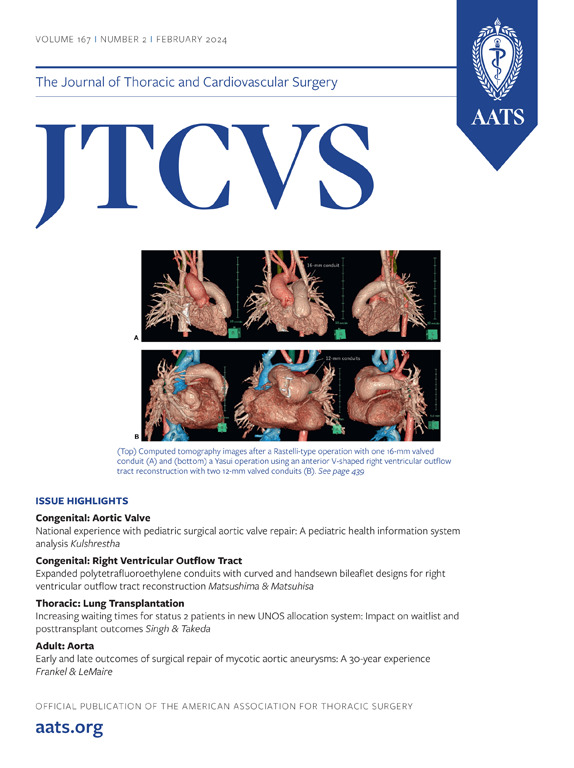Predictive modeling of endocardial fibroelastosis recurrence in patients with congenital heart disease
IF 4.9
1区 医学
Q1 CARDIAC & CARDIOVASCULAR SYSTEMS
Journal of Thoracic and Cardiovascular Surgery
Pub Date : 2025-02-01
DOI:10.1016/j.jtcvs.2024.08.036
引用次数: 0
Abstract
Background
Endocardial fibroelastosis (EFE) is a major effector in the maldevelopment of the heart in patients with congenital heart disease. Despite successful surgical removal, EFE can redevelop, but the underlying cause of EFE recurrence remains unknown. This study aimed to identify hemodynamic predictors and genetic links to epithelial/endothelial-to-mesenchymal transition (EMT/EndMT) alterations for preoperative risk assessment.
Methods
We assessed the impact of preoperative hemodynamic parameters on EFE recurrence in a cohort of 92 patients with congenital heart disease who underwent left ventricular (LV) EFE resection between January 2010 and March 2021. Additionally, whole-exome sequencing in 18 patients was used to identify rare variants (minor allele frequency <10−5) in high-expression heart (HHE) genes related to cardiac EMT/EndMT and congenital heart disease.
Results
EFE recurred in 55.4% of patients, within a median of 2.2 years postsurgery. Multivariable analysis revealed specific hemodynamic parameters (mitral valve inflow and area, LV filling pressure, and aortic valve gradient and diameter) as predictors, forming a predictive model with an area under the receiver operating characteristic curve of 0.782. Furthermore, 89% of the patients exhibited damaging variants in HHE genes, with 38% linked to cardiac EMT/EndMT Gene Ontology processes and 22% associated with known congenital heart disease genes. Notably, HHE genes associated with cardiac EMT/EndMT were significantly associated with faster EFE recurrence in a multivariate analysis (hazard ratio, 3.56; 95% confidence interval, 1.24-10.17; P = .018).
Conclusions
These findings established a predictive scoring system using preoperative hemodynamic parameters for EFE recurrence risk assessment. Alterations in HHE genes, particularly those linked to cardiac EMT/EndMT, exacerbate the risk of recurrence.
先天性心脏病患者心内膜纤维细胞增生症复发的预测模型
目的:心内膜纤维细胞增生症(EFE)是先天性心脏病患者心脏发育不良的主要影响因素。尽管手术成功切除了EFE,但EFE仍有可能再次发生,但EFE复发的根本原因仍不清楚:本研究旨在确定血液动力学预测因素以及上皮/内皮到间质转化(EMT/EndMT)改变的遗传联系,以便进行术前风险评估:我们评估了2010年1月至2021年3月期间接受左心室(LV)EFE切除术的92例先天性心脏病患者队列中术前血液动力学参数对EFE复发的影响。此外,还对 18 名患者进行了全基因组测序,以确定罕见变异(小等位基因频率结果):55.4%的患者在术后2.2年内复发。多变量分析显示,特定的血流动力学参数(二尖瓣流入量和面积、左心室充盈压、主动脉瓣梯度和直径)是预测因素,形成了一个AUC为0.782的预测模型。此外,89%的患者表现出HHE中的损伤性变异,其中38%与心脏EMT/EndMT GO过程有关,22%与已知的CHD基因有关。值得注意的是,在多变量分析中,与心脏EMT/EndMT相关的HHE基因与EFE复发速度显著相关(HR 3.56,95% CI 1.24-10.17,p=0.018):这些研究结果建立了一个利用术前血流动力学参数进行EFE复发风险评估的预测评分系统。HHE基因的改变,尤其是与心脏EMT/EndMT相关的基因的改变,会增加复发风险。
本文章由计算机程序翻译,如有差异,请以英文原文为准。
求助全文
约1分钟内获得全文
求助全文
来源期刊
CiteScore
11.20
自引率
10.00%
发文量
1079
审稿时长
68 days
期刊介绍:
The Journal of Thoracic and Cardiovascular Surgery presents original, peer-reviewed articles on diseases of the heart, great vessels, lungs and thorax with emphasis on surgical interventions. An official publication of The American Association for Thoracic Surgery and The Western Thoracic Surgical Association, the Journal focuses on techniques and developments in acquired cardiac surgery, congenital cardiac repair, thoracic procedures, heart and lung transplantation, mechanical circulatory support and other procedures.

 求助内容:
求助内容: 应助结果提醒方式:
应助结果提醒方式:


